NISM - Unit Objectives & Reflections

This page contains the objectives, outcomes and reflections of each unit (week) of the module. Please click on the headings to expand the notes.
Unit 1 - Network and Information Security Management: History & Definitions
Unit 1 - Network and Information Security Management: History & Definitions
Objectives
- Define the four tenets of security and understand how they underpin the field of Information Security.
- Become familiar with the key international standards that define Information Security Management.
- Review the two core concepts of Information Security – vulnerabilities and threats – and understand how they are related and how they can be classified and assessed.
- Identify a range of professional roles that are available in the Information Security field.
Outcomes
- Explain the basic principles of Information Security Management.
- Describe the 4 tenets/ principles of Information Security Management.
- Describe what constitutes a threat and vulnerability.
- List several common roles within the Information Security profession.
Reflection on Unit 1
Unit 1 represented the first week of the Network and Information Security Management course. The basics of information and security management were discussed in this Unit. Having prior experience in networking, I was particularly excited as some of the topics covered would suffice as a good refresher. Students were expected to complete an initial post covering major threats and vulnerabilities as well as mitigation techniques from a paper written by Glisson et al. (2015).
Team groups were also established in preparation for the first seminar. I was placed in Group 1 along with 4 other team members. It was also required that we submit a signed team contract before the end of the Unit. Messaging between myself and other team members started on the VLE (Virtual Learning Environment) platform and thereafter moved to e-mails, however this was not effective. For us to collaborate as a team I had set up a Webex space and had invited all team members to download the application. The first meeting was held 2 days after the seminar, the agenda included completing the team contract along with an introduction of each team member. It was very interesting to learn the backgrounds of each team member and how they would add value to the tasks and group as a whole. We had agreed on the various roles within the group, I had taken the role of communication leader responsible for all communication as well as setting up meetings for the group. Coming from a unified communication background, I had experience using collaboration tools such as Webex and had agreed to take up the role. The team contract was finalized and submitted after the meeting.
Figure 1 below represents the Webex space created for our team:


As mentioned previously an initial post was also due at the end of the week which involved around 5 hours of research to obtain relevant papers. My knowledge of the medical environment as well as medical technologies was limited, and this task provided a good opportunity to fill that gap. I had learnt about the importance of securing medical devices and the implications of attacks on these devices (Williams & Woodward, 2015).
In addition, I had planned to draw up an action plan for my e-portfolio during this week however this was not possible due to time constraints. This was then placed on the backlog list for completion during Unit 2.
References
Glisson, W., Andel, T., Mcdonald, J., Jacobs, M., Campbell, M. & Mayr, J. (2015). Compromising a Medical Mannequin. Available from: https://www.researchgate.net/publication/281487935_Compromising_a_Medical_Mannequin [Accessed 13 November 2021].
Williams, P. A., & Woodward, A. J. (2015). Cybersecurity vulnerabilities in medical devices: a complex environment and multifaceted problem. Medical devices. Health Informatics Journal, 25(2): 305–316. Available from: https://journals.sagepub.com/doi/pdf/10.1177/1460458217706184 [Accessed 14 November 2021].
Unit 2 - Real World Issues & Implications of Information Security Threats & Vulnerabilities
Unit 2 - Real World Issues & Implications of Information Security Threats & Vulnerabilities
Objectives
- Review the vulnerabilities of modern electronic medical devices.
- Discuss the use of exploitation software to create threats.
- Classify and evaluate the combination of threats and associated vulnerabilities and the impact on real-world devices.
Outcomes
- Describe a number of typical vulnerabilities of modern electronic devices.
- Explain how common vulnerabilities can be exploited using software toolkits.
- Use industry standard toolkits to classify and evaluate threats and vulnerabilities.
Reflection on Unit 2
In addition to the essential reading items, Unit 2 of the module involved responding to colleague’s initial posts in the form of peer responses. Various research papers and journals were studied in order obtain the relevant information to form constructive peer responses. Some of these include: Sametinger et al. (2015) - Security challenges for medical devices, Williams, P. A., & Woodward, A. J. (2015) - Cybersecurity vulnerabilities in medical devices: a complex environment and multifaceted problem, Wang et al., 2020 - Security of Medical Cyber-physical Systems. Full references for these texts are provided below.
The collaborative discussions have been helpful, learning and understanding from my colleagues’ viewpoints. Everyone brings a different perception and angle to the discussion. I have learnt the distinct difference between a threat and vulnerability; this wasn’t clear to me prior to completing the Unit tasks. My knowledge has also expanded regarding the security issues that medical devices face, I had very little knowledge on the technology advancements in this area. I have also learnt how to correctly (in my opinion) perform a DREAD analysis; this was also a new concept for me. From this collaboration task it was clear that I had to perform extensive reading on the topics to fill the knowledge gaps that I had.
A seminar was also held during this unit which focused on Microsoft STRIDE and DREAD tools. A presentation was required by each group for discussion during the seminar. I had studied the chapter called Threat Modeling by Meier et al. (2010) and using the table below performed a DREAD analysis.
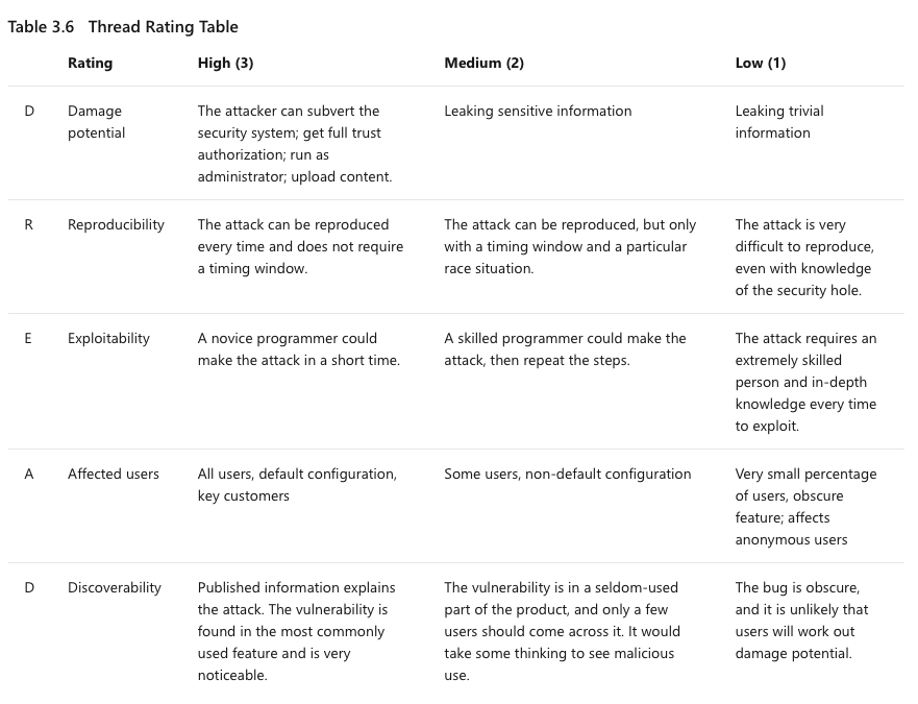
This was placed in a presentation format for discussion during the team meeting. I had posted this to the other team members in preparation for the upcoming session.
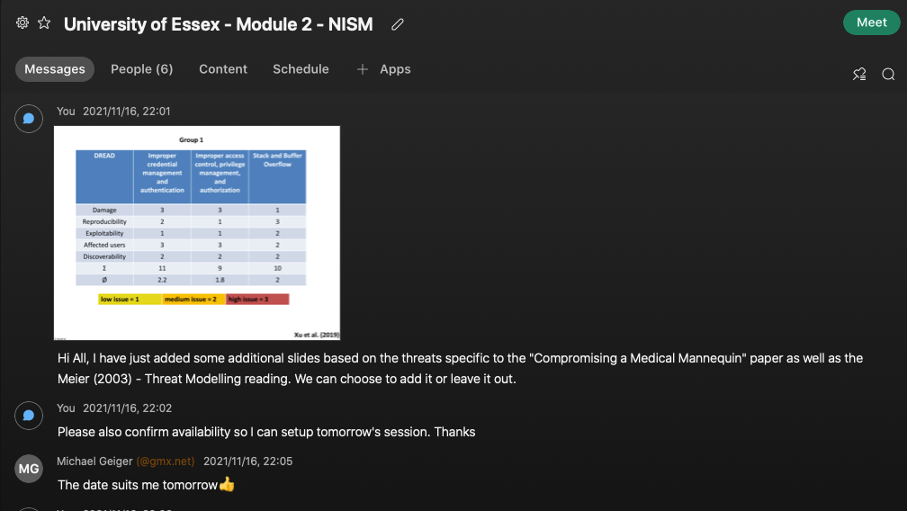
During the team meeting it was agreed that we would use my slides to present to the forum in the seminar. As a team, we had analysed the DREAD value ratings and adjusted them accordingly. Based on the feedback from my peers during the session I had felt confident that my understanding of the task required and dread value ratings were correct. Prior to the team session I could not validate and confirm this.
References
Meier, J., Mackman, A., Dunner, M., Vasireddy, S., Escamilla, R. & Murukan, A. (2003) ‘Improving Web Application Security: Threats and Countermeasures - Threat Modelling’. Microsoft Corporation. Available from: https://docs.microsoft.com/en-us/previous-versions/msp-n-p/ff648644(v=pandp.10) [Accessed 20 November 2021].
Sametinger, J., Rozenblit, J., Lysecky, R., & Ott, P. (2015). Security challenges for medical devices. Communications of the ACM, 58(4): 74–82. Available from: https://dl.acm.org/doi/fullHtml/10.1145/2667218 [Accessed 20 November 2021].
Williams, P. A., & Woodward, A. J. (2015). Cybersecurity vulnerabilities in medical devices: a complex environment and multifaceted problem. Medical devices. Health Informatics Journal, 25(2): 305–316. Available from: https://journals.sagepub.com/doi/pdf/10.1177/1460458217706184 [Accessed 20 November 2021].
Wang, Z., Ma, P., Zou, X., Zhang, J., & Yang, T. (2020) ‘Security of Medical Cyber-physical Systems: An Empirical Study on Imaging Devices’, IEEE INFOCOM 2020 - IEEE Conference on Computer Communications Workshops. Canada, 6-9 July 2020. USA: IEEE. Available from: https://ieeexplore.ieee.org/document/9162769 [Accessed 20 November 2021].
Unit 3 - Network Fundamentals
Unit 3 - Network Fundamentals
Objectives
- Present a brief history of networking.
- Discuss the ISO/OSI 7-layer model and how it relates to modern networks.
- Introduce TCP/IP and describe how it forms the basis of the Internet.
- Describe some basic internet tools including ping, traceroute and dig.
- Discuss what is meant by IPv4 and IPv6.
Outcomes
- Describe the fundamental concepts of networks.
- Evaluate a number of widely available tools to use for basic network troubleshooting.
- Explain the differences between the IPv4 and IPv6 standards.
Reflection on Unit 3
Week 3 focused on the fundamentals of networking and utilizing various scanning tools to perform a scanning exercise against the website assigned. A summary post was required based on the initial post written in week 1 as well as feedback from peers in the form of peer responses. It was very beneficial to read and understand the views of my peers, each person brings a different and unique viewpoint. This aided my understanding regarding threats, vulnerabilities, and mitigation actions in medical devices.
A practical scanning exercise was also required in this unit, this activity provided the opportunity to learn about various scanning tools in the industry. Regarding the team activity, each member produced results in a team discussion. These results were then discussed in a team meeting and aligned. I was very happy with the results I had obtained as it aligned with the rest of the team. The screenshot below provides evidence of my results sent to the team.
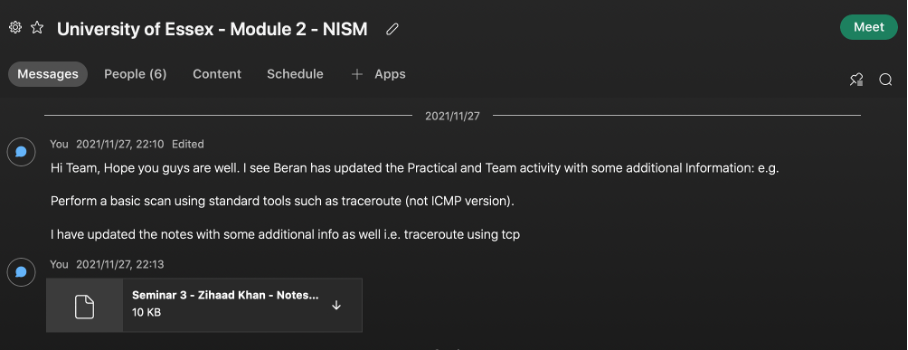
Perhaps for future scanning activities, one could use alternative tools to validate these results.
Unit 4 - Basic Network Investigation Using Standard Tools
Unit 4 - Basic Network Investigation Using Standard Tools
Objectives
- Practice using built in utilities for network troubleshooting.
- Discuss the outputs produced by those tools.
- Read and discuss the paper in the reading list.
Outcomes
- Perform basic troubleshooting and investigations using the tools provided as part of common operating systems (tools such as ping, traceroute and so on).
- Analyse the outputs provided by the tools.
- Discuss the difference between TCP/IP and the ISO/OSI protocol stacks.
Reflection on Unit 4
Unit 4 dived a bit deeper into network scanning tools. We were asked to analyze the outputs provided by the tools in Unit 3, the analyses were to be posted under the collaborative learning discussion forum as an ‘Initial Post’. Having prior experience working with networking tools I felt this task to be quite familiar and easily achievable. On the contrary after read McNab (2017) I was amazed at what details I was missing when these tools were used. For example, nmap (Network Mapper) was used to determine open ports, however knowing the port 80 is open; one can execute the telnet command and issue a HEAD / HTTP/1.0 request – this reveals that the server is running Apache.
In addition, a seminar was held during this unit which focused on the differences between TCP/IP vs. ISO/OSI. Again, having been in the networking industry this provided me with the opportunity to delve a bit deeper into the history of both models and how they came about. I was particularly amazed how politics affected the development of these models (Russell, 2006).
References
McNab, C. (2017) Network Security Assessment: Know Your Network. 3rd ed. O'Reilly Media
Russell, A.L. (2006) ‘Rough Consensus and Running Code’ and the Internet-OSI Standards War. IEEE Annals of the History of Computing. Available from: https://www2.cs.duke.edu/courses/common/compsci092/papers/govern/consensus.pdf [Accessed 04 December 2021].
Unit 5 - Network Tools and Components
Unit 5 - Network Tools and Components
Objectives
- Review the functions of the wide variety of network components such as switches, routers, firewalls and gateways.
- Describe the role of networking equipment in virtualised environments such as the cloud.
- Discuss advanced network diagnostic tools such as scanners and packet sniffers.
Outcomes
- Describe the different network tools and components available.
- Explain when and where to use selected tools and components.
- Evaluate the security implications of using selected components.
Reflection on Unit 5
The focus of week 5 was based on network protection and various intrusion detection tools. It was also required during this unit that students participate in the collaboration discussion and respond to other colleagues ‘initial post’ in the form of peer responses. The highlight of this unit for myself was reading the following paper by Niemietz and Schwenk (2015) titled: Owning Your Home Network: Router Security Revisited. I was amazed at how manufacturers of routers can ship routers out to homes with default passwords being used for the administration interface. Furthermore, these routers were found to be vulnerable to Cross Site Scripting (XSS) and Cross Site Forgery (CSFR) attacks. This research tempted me to look at my own home router configuration and implement some of the recommendations put forward. For example, default router passwords were changed, firmware versions upgraded, and wireless security enhanced by utilizing WPA2 instead of WPA (Wifi Protected Access). I found this exercise to be a very good example of putting theory studied into practice.
References
Niemietz, M. and Schwenk, J. (2015) Owning Your Home Network: Router Security Revisited. Available from: https://www.researchgate.net/publication/278332193_Owning_Your_Home_Network_Router_Security_Revisited [Accessed 06 December 2021].
Unit 6 - An Evaluation of Commonly Utilised Network Scanning and Vulnerability Testing Tools
Unit 6 - An Evaluation of Commonly Utilised Network Scanning and Vulnerability Testing Tools
Objectives
- Evaluate network scanning and intrusion tools.
- Submit part 1 of your course assessment – the proposal.
Outcomes
- Select a toolset to use for scanning and vulnerability testing.
- Justify your selection.
- Submit the first part of your course assessment.
Reflection on Unit 6
This was the most time-consuming unit thus far as the focus was on the Team Design Project. By this time two members of Group 1 had already dropped out forcing the remaining three members to work even harder at completing the task at hand. We had already performed the background research (i.e., governing bodies and associated regulations applicable) required for the project. The outstanding items that needed to be developed was the following: structure and layout of the document as well as the final table that needed to go in. I had agreed with the team that I will take the lead in compiling this document as well as producing the final table of results. The information gathering was a challenging task for me as it required reading and understanding many research papers based on threats and vulnerabilities of e-commerce websites. Nevertheless, I had persevered and manage to submit the first draft to the group for review (depicted in the screenshot below).
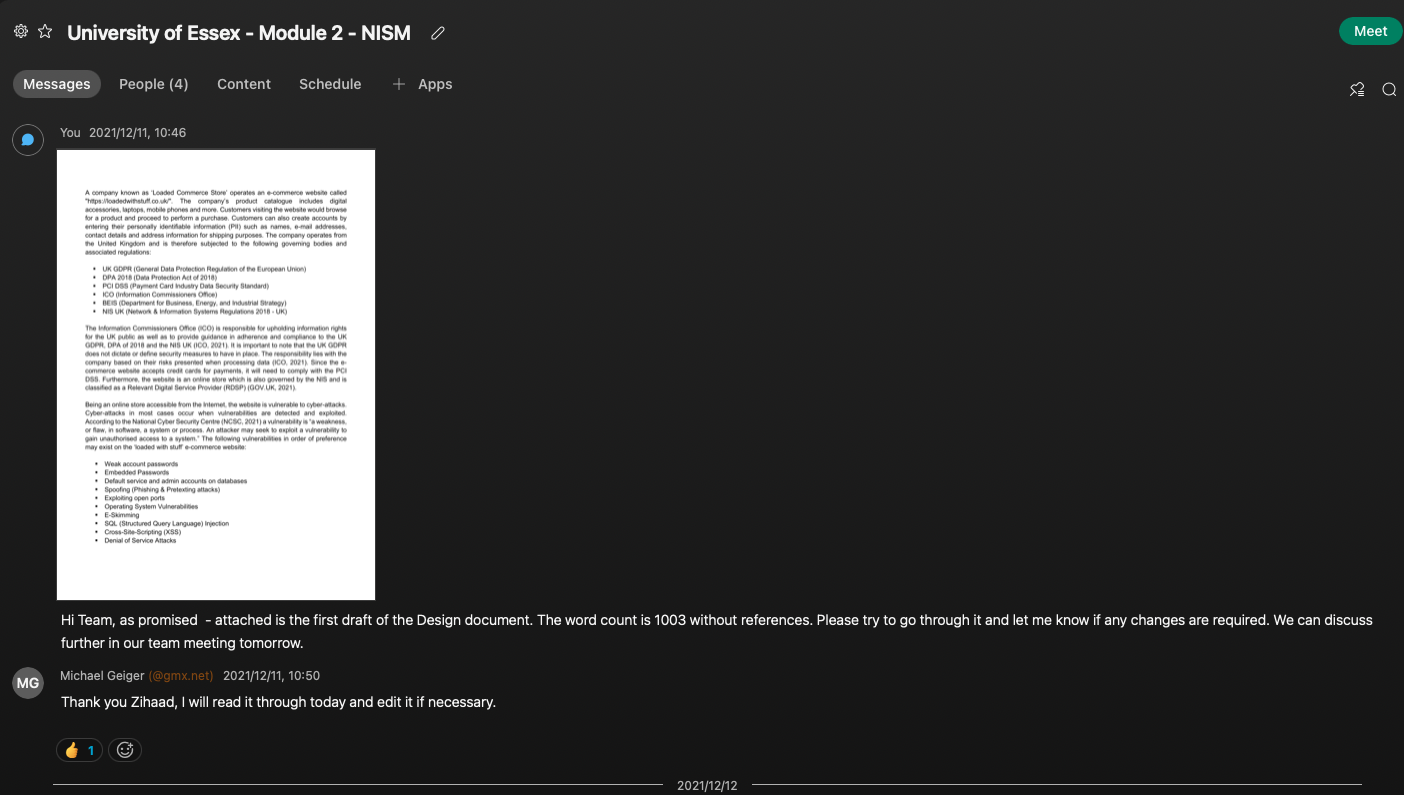
Minor changes were made by the team members such as grammar, proof reading and references. The project was then submitted 4 days ahead of the due date.
Unit 7 - Risks and Standards
Unit 7 - Risks and Standards
Objectives
- Review what is meant by risk within the context of Information Security Management.
- Discuss how to gather, analyse and mitigate risks from a security audit/ review/ planning session.
- Review business continuity and disaster recovery standards.
- Explore industry specific security standards and directives.
Outcomes
- Describe the purpose of risk assessment.
- Explain how to mitigate risks.
- Describe the difference between business continuity and disaster recovery.
- List common security standards and select the appropriate one(s) for a given situation.
Reflection on Unit 7
The tasks and objectives for Unit 7 provided us with the opportunity to get our hands dirty by utilizing the various scanning and vulnerability tools. Utilizing Kali Linux was the focus of this unit to complete the e-Portfolio activity as well as the scanning exercise. By far this was the most exciting unit as I am a very hands-on person. As mentioned in the previous reflections I have extensive experience in networking and system administration skills. The tasks in this unit allowed me to build on that experience by getting familiar with the Kali Linux installation as well as using the various scanning tools installed by default. I had installed VirtualBox on my laptop which provided the virtualization layer and thereafter installed a Kali Linux distribution. The installation was quite simple with no challenges experienced. The document below represents the scanning results achieved using Kali Linux.
Click here to download the e-Portfolio activity
Unit 8 - How to Evaluate and Apply Applicable Security Standards
Unit 8 - How to Evaluate and Apply Applicable Security Standards
Objectives
- Review and discuss a number of GDPR related case studies.
- Review standards web sites.
- Discuss case studies and standards on the forum.
Outcomes
- Explain which GDPR regulations are applicable to their assigned website.
- Describe which other standards their assigned website needs to meet.
- Advise on mitigations to help a website meet any of the standards applicable to its specific industry, such as data and privacy (GDPR) or financial (PCI-DSS).
Reflection on Unit 8
The focus of Unit 8 was based on the General Data Protection Regulation (GDPR) and the Payment Card Industry Data Security Standard (PCI-DSS). The assignment for this unit was to select a GDPR case study and provide mitigation actions and recommendations applicable to the company in question. Prior to this unit we did not focus heavily on the details of the GDPR, this task had changed that perspective. I found myself studying specific articles in the GDPR act (Intersoft Consulting, N.D) that were applicable to the Virgin Media Ireland Limited case study. For example, the notes below is an extract from my ‘initial post’:
In terms of the General Data Protection Regulation (GDPR) act, Virgin Media Ireland Limited was in breach of the following articles (Intersoft Consulting, N.D):
- Article 6: Lawfulness of processing – since the data subject has not given consent to the organisation to process her data.
- Article 7: Conditions for consent – since Virgin Media Ireland Limited was unable to demonstrate consent received from the complainant.
- Article 21: Right to Object – since the data subject has objected to the processing of her data for direct marketing purposes.
A real eye opener for me was that many companies breach these regulations and do have GDPR policies or even security officers in place to ensure compliancy.
References
Intersoft Consulting (N.D) General Data Protection Regulation. Available from: https://gdpr-info.eu/art-95-gdpr/ [Accessed 22 January 2022].
Unit 9 - System Logging and Forensics
Unit 9 - System Logging and Forensics
Objectives
- Review the types of logs and tools used to view logs.
- Explore different types of logging and analysis tools.
- Describe the steps involved in a security breach response.
- List a number of tools used for forensic investigations.
Outcomes
- Explain how and why logging is used in security systems.
- Describe which tools to use for logging and analysis.
- Explain how logging is used in incident investigations.
- Describe the best forensic techniques to use.
Reflection on Unit 9
The focus of unit 9 was based solely on two techniques used in security incident investigations: logging and forensics. According to Eaton (2003): "Logging is a fundamental requirement of any system, as things will go wrong, we need a way to diagnose and isolate the cause.” This statement is true and relevant to the current industry that we are working in, without proper logging in place organisations would struggle to determine the cause of data breaches. As mentioned in the previous reflections above, my current role at my organization involves troubleshooting Voice over IP (VoIP) incidents many of which involves tailing lengthy log files. The notes presented in the lecturecast for this unit supplemented my knowledge on the logs available for many Unix based systems. Examples include web server logs would usually be found in the ‘/var/log/httpd’ directory while database logs would be found in the ‘/var/log/mysqld.log’ logfile for servers running MySQL.
References
Eaton, I. (2003) The Ins and Outs of System Logging Using Syslog. Available from: https://www.sans.org/reading-room/whitepapers/logging/ins-outs-system-logging-syslog-1168 [Accessed 24 January 2022].
Unit 10 - Analysing and Mitigating Security Breaches
Unit 10 - Analysing and Mitigating Security Breaches
Objectives
- Discuss a number of case studies related to the most famous breaches of the 21st century.
- Apply the breach checklist provided in the lecturecast.
- Analyse an assigned case study and post results.
Outcomes
- Utilise the breach checklist to analyse a breach.
- Recommend a number of actions and tools based on the analysis.
- Critically assess published responses.
Reflection on Unit 10
Unit 10 focused on selecting and analyzing data breaches that had occurred on many high-profile organisations. For Group 1 the case study selected was Marriott international which is a US-based hospitality company. A data breach on their network occurred in 2018 that involved for than 500 million guests (Starwood hotels, 2018). PII (Personally Identifiable Information) including credit cards and passport numbers were exposed. In addition to the case study, we were asked to provide mitigation actions to prevent such data breaches. Group 1 provided the following:
- Keep encrypted data and the keys used to encrypt it separated from each other.
- Phase out Starwood systems and accelerate security enhancements to its network.
- Implement access control together with an Identity and Access Management (IAM) system with MFA to any network devices.
- Implement endpoint security tools such as anti-virus and anti-malware.
- Create a security monitoring team that constantly monitors the network. This includes unusual/suspicious access to database systems.
Some of the mitigation actions provided above relate back to the Unit 6 – Initial Design Document. It was fulfilling to see that some of the recommendations mentioned in the initial design document were relevant for this case study as well. What this indicates is that some security standards are consistent across various industries. This was quite a useful exercise as it validated our knowledge on mitigation actions.
References
Starwood hotels (2018). Original notice from November 30, 2018. Available from: http://starwoodstag.wpengine.com/wp-content/uploads/2019/05/us-en_First-Response.pdf [Accessed 26 January 2022].
Unit 11 - Future Trends, Technologies and Challenges for the Information Security Industry
Unit 11 - Future Trends, Technologies and Challenges for the Information Security Industry
Objectives
- Review existing and emerging trends and technologies such as SDN and FIAs.
- Discuss some of the security challenges they are designed to overcome.
- Describe the associated issues with new technologies.
Outcomes
- Describe emerging trends and technologies.
- Explain the impact of emerging changes.
- Describe some challenges encountered with both current and new solutions.
Reflection on Unit 11
Unit 11 was by far the most demanding unit as it consumed the most amount of time from all units. The development project was due at the end of this unit together with the team activity debate which made it very challenging. It was also at the start of this unit that 1 more team member had dropped out of the module, leaving two members (Michael Geiger and I) in Group 1. Between Michael and I we had come up with an action plan on how to complete and submit the design project ahead of the due date as we both needed to focus on our e-portfolio after submitting the project. It was agreed that I would compile the final report for submission. We had broken the project up into sections i.e., Objectives, Methodology, Assumptions, Results and Recommendations and thereafter contributed to each section accordingly. Team meetings moved from once a week to twice a week in order track and make progress continuously on the project. We were in constant communication discussing our results by means of the Webex chat group set up in the first week of the module. To our amazement we had completed the project (including proofreading it more than 3 times) and submitted it 2 days ahead of schedule. It is projects like these where you come to learn more about yourself and how you would perform under pressure. What we had learnt from this exercise as a group is that the earlier we start with a project the more time we have to finish it.
Unit 12 - Debate on the Future of the Internet
Unit 12 - Debate on the Future of the Internet
Objectives
- Review the options for the future Internet architecture.
- Debate the future of the Internet.
- Vote on the most popular option (as presented in the debate) that should be adopted.
Outcomes
- Describe several potential future Internet architectures.
- Argue for and against several architectures.
- Reflect on the role of Information Security Management in modern computing solutions.
Reflection on Unit 12
Unit 12 focused on the future of the internet between various designs in the industry. There were four design options discussed viz. Content Centric Networking (CCN), peer-to-peer based overlay networking, Mobility First architecture and the adoption of IPv6. Group 1 was given design option 1 – CCN. The topic was discussed in our last team meeting in detail and a presentation was created for the final seminar. Michael and I had agreed that the CCN architecture was based on content cache and delivery which brings about further advantages such as network load reduction, enhance router storage and shorter downloading times (Mishra & Dave, 2015). I unfortunately couldn’t make the last seminar as it clashed with a work meeting, as a result Michael had agreed to present. The debate task provided a great opportunity to research the various design methods mentioned above and understand the history, current times, and the future of the internet.
References
Mishra, G, P., & Dave, M. (2015) ‘A Review on Content Centric Networking and Caching Strategies’, 2015 Fifth International Conference on Communication Systems and Network Technologies. India, 4-6 April 2015. USA: IEEE. Available from: https://ieeexplore.ieee.org/document/7280055 [Accessed 14 February 2022].
Final Reflection of the NISM Module (<1000 words)
Final Reflection of the NISM Module (<1000 words)
The Network Information and Security Management (NISM) module has broadened my perspective on the topics of networking, monitoring and logging tools, principles of information security as well as vulnerability and scanning tools.
Students were placed into 3 groups at the start of the Module, I was part of Group 1. Two projects i.e. a team design document and a team executive summary were completed as part of this module as well various collaboration discussions and vulnerability scanning exercises.
The collaborative discussions created an opportunity for me to learn and understand from my colleagues’ viewpoints. Everyone brings a different perception and angle to the discussion. I have learnt the distinct difference between a threat and a vulnerability; this wasn’t clear to me prior to completing the unit tasks. As Campbell (2016) states that “the potential cause of an unwanted incident, which may result in harm to a system or organization” is called a threat and “a weakness of an asset or control that can be exploited by one or more threats” is known as a vulnerability. My knowledge has also expanded on the security issues that medical devices faced, as I had very little knowledge on the technology advancements in this area. I have also learnt how to correctly perform a DREAD analysis, which was a new concept to me. From the collaboration tasks it was clear that I had to perform extensive reading on the topics to fill the knowledge gaps that I had.
Group 1 was assigned the website called https://loadedwithstuff.co.uk and was asked to theoretically identify vulnerabilities and provide recommendations as part of the team design document project. Furthermore, regulations such as the General Data Protection Regulation (GDPR), Information Commissioners Office (ICO) as well as Payment Card Industry Data Security Standard (PCI-DSS) needed to be taken into account. Information gathering for this project was a challenging task for me as it required reading and understanding many research papers based on threats and vulnerabilities specific to e-commerce websites.
The second project (executive summary document) required groups to use various scanning tools to identifying vulnerabilities as well as provide recommendations and mitigating actions to secure the website in question. One of the ways that cybersecurity professionals attempt to secure websites and servers is by performing regular scans and penetration testing using various scanning tools. The purpose of a scanning tool is to acquire more information about a specific host or target (I.T Governance Ltd, 2021).
The two projects mentioned above allowed individuals, and the group as a whole to acquire a great deal of knowledge in identifying and analysing vulnerabilities in systems as well as provide meaningful recommendations. Furthermore, these tasks provided the opportunity to study the governing body and associated regulations (GDPR, ICO, PCI-DSS) in more detail as well as become fluent in using Kali Linux to perform penetration testing exercises.
Scanning exercises provided the opportunity to learn about various scanning tools in the industry. Regarding the team activity, each member produced results in a team discussion. These results were discussed in a team meeting and were then aligned. I was very happy with the results I had obtained as it aligned with the rest of the team confirming and validating my knowledge on the topic. Figures 2 and 3 below provides evidence of collaborating with the team:
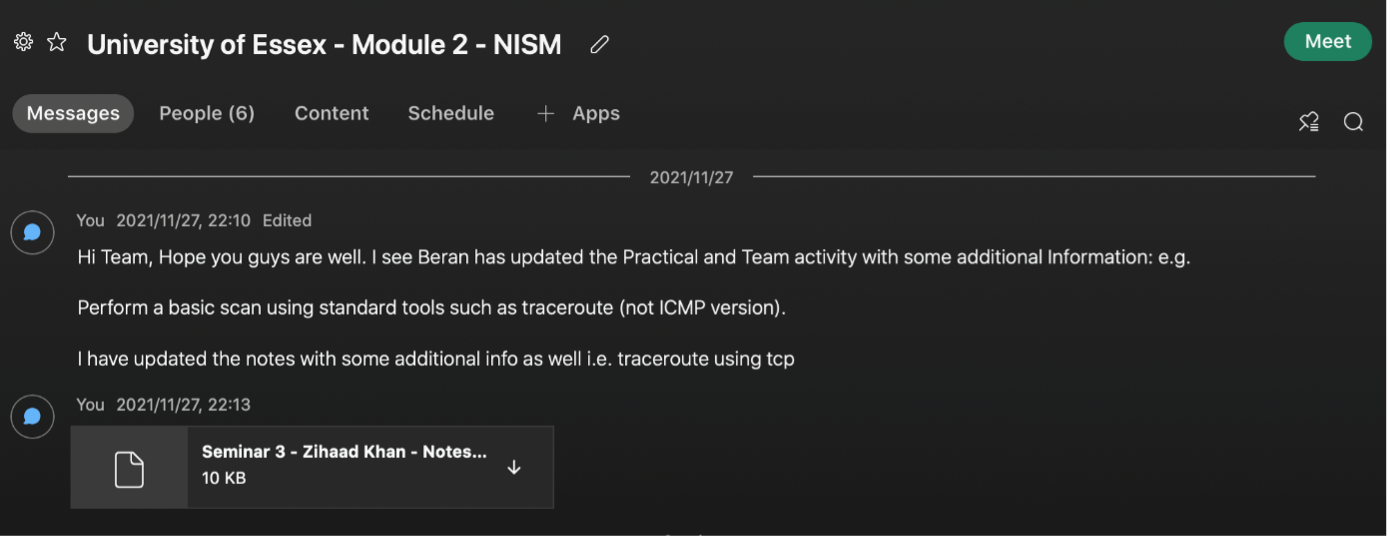
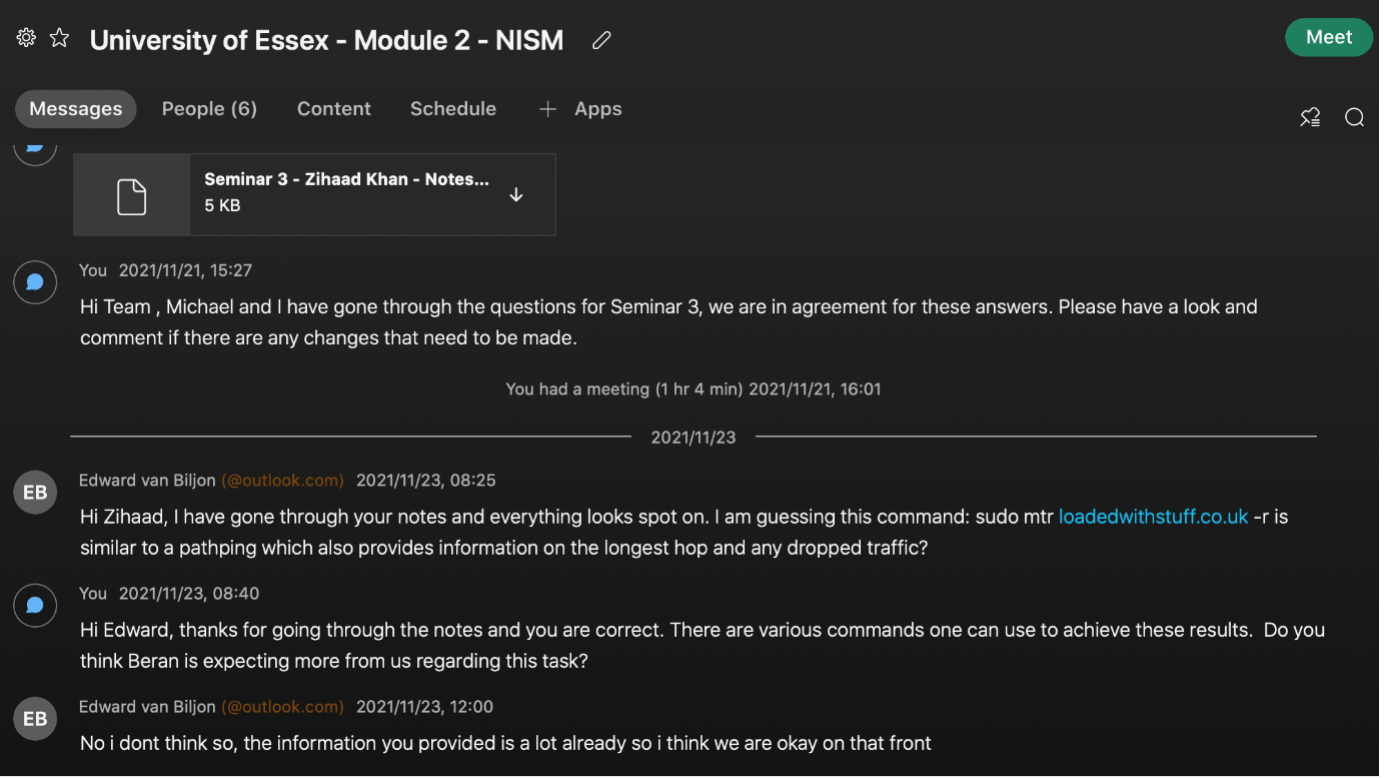
The two projects as well as many activities were completed as a group. Feedback from team members is very beneficial as they provide a different way of thinking and analysing problems. Working in a team has its disadvantages as well, we as group 1 were unfortunate to lose 3 members of the team during the module. This loss placed the team under immense pressure to achieve the desired outcomes planned at the start of the module. This meant that each of the remaining team members (2) had to take on additional responsibilities. During the first unit the group was required to complete a team contract outlining roles and responsibilities of each team member. One item that we did not cover in the team contract was how to handle the workload if team members decide to drop out of the module. After a last-minute discussion, the remaining two members decided that frequent meetings (twice a week) would be required for us to collaborate more closely. This meant that more time had to be dedicated to the module than was originally planned. I was worried that this matter may have an impact on our grades if a good design project is not produced. Managing time was key to completing tasks given to other members who have exited the course. Miqdadi et al. (2014) mentions “that time management is extremely important, especially when it comes to university students because it will boost their grades and enhance their productivity.” On the positive side, the added pressure forced us to work harder and smarter to achieve the objectives and complete tasks ahead of schedule. It is projects like these where you come to learn more about yourself and how you would perform under pressure.
On the contrary, I felt that the time allocated to complete various tasks in the units was not accurate, in some instances it would take double the amount of time allocated to complete a task. For some units seminars were held the day after the unit started for example, the unit started on a Tuesday and seminars were held on a Wednesday. The time required to adequately prepare for these seminars were insufficient.
Lastly the module has provided me with opportunities to explore various concepts on information security, industry regulations, as well as a comparison on the latest scanning tools. It was very intellectually stimulating, motivating and has challenged me to achieve my best work. Furthermore I believe that I have progressed with skills such as time management; from reading essential items in a unit, preparing for seminars and having group discussions, I soon realised that time management became an essential skill to possess.
References
Campbell, T. (2016) Practical Information Security Management. 1st ed. APRESS.
I.T Governance Ltd (2021) Vulnerability scanning: what it is and how it works. Available from: https://www.itgovernance.co.uk/vulnerability-scanning [Accessed 18 December 2021].
Miqdadi, F.Z., Almomani, A.F., Masharqa, S., & Elmousel, N.M. (2014) ‘The Relationship between Time Management and the Academic Performance of Students from the Petroleum Institute in Abu Dhabi, the UAE’, ASEE 2014 Zone I Conference. University of Bridgeport, Bridgpeort, CT, USA, 3-5 April. 1-5.
Click here to download the above reflection in a .pdf format